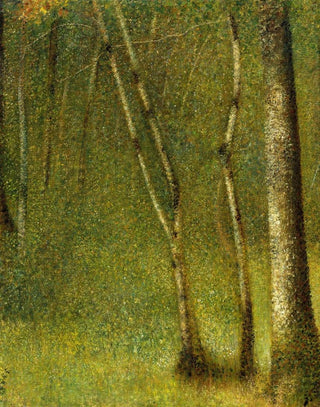Art print | La Forêt de Pontaubert - Georges Seurat


View from behind

Frame (optional)
La Forêt de Pontaubert, a quintessential Georges Seurat art print, unfolds as a true visual poem, an invitation to immerse oneself in the captivating universe of pointillism. Created in 1886, this painting transports us to the heart of lush nature, bathed in light and shadow, where each brushstroke of color seems to pulse with its own energy. Seurat, a pioneer of an innovative technique, masterfully captures the essence of a moment suspended in time, both intimate and universal. Through this art print, he offers a poetic vision of nature—a sanctuary of serenity where the viewer's eye is guided by a subtle play of nuances and shapes.
Style and uniqueness of the art print
The Forêt de Pontaubert stands out for its masterful use of pointillism, which Seurat develops with scientific rigor. Each dot of color, meticulously applied, contributes to creating an immersive atmosphere where light appears to dance across the foliage and tree trunks. The composition, both harmonious and dynamic, invites the viewer to explore the depths of the canvas, revealing unexpected details upon closer inspection. The interplay of light, contrasts between shadow and clarity, as well as the delicate palette of greens and browns, evoke a sense of freshness and vitality. This art print is not merely a landscape; it becomes a sensory experience—a celebration of nature and its mysteries.
The artist and his influence
Georges Seurat, a major figure of the neo-impressionist movement, left a lasting mark on art history through his innovative approach. Born in 1859, he developed a painting method based on the study of colors and visual perceptions. His pointillism technique, which involves juxtaposing small dots of color, influenced many artists and subsequent artistic movements. Seurat sought not only to depict reality but to explore its perceptual mechanisms. His legacy is reflected in the works of painters like Paul Signac and even in Fauvism. The Forêt de Pontaubert, in particular, exemplifies his desire to

Matte finish

View from behind

Frame (optional)
La Forêt de Pontaubert, a quintessential Georges Seurat art print, unfolds as a true visual poem, an invitation to immerse oneself in the captivating universe of pointillism. Created in 1886, this painting transports us to the heart of lush nature, bathed in light and shadow, where each brushstroke of color seems to pulse with its own energy. Seurat, a pioneer of an innovative technique, masterfully captures the essence of a moment suspended in time, both intimate and universal. Through this art print, he offers a poetic vision of nature—a sanctuary of serenity where the viewer's eye is guided by a subtle play of nuances and shapes.
Style and uniqueness of the art print
The Forêt de Pontaubert stands out for its masterful use of pointillism, which Seurat develops with scientific rigor. Each dot of color, meticulously applied, contributes to creating an immersive atmosphere where light appears to dance across the foliage and tree trunks. The composition, both harmonious and dynamic, invites the viewer to explore the depths of the canvas, revealing unexpected details upon closer inspection. The interplay of light, contrasts between shadow and clarity, as well as the delicate palette of greens and browns, evoke a sense of freshness and vitality. This art print is not merely a landscape; it becomes a sensory experience—a celebration of nature and its mysteries.
The artist and his influence
Georges Seurat, a major figure of the neo-impressionist movement, left a lasting mark on art history through his innovative approach. Born in 1859, he developed a painting method based on the study of colors and visual perceptions. His pointillism technique, which involves juxtaposing small dots of color, influenced many artists and subsequent artistic movements. Seurat sought not only to depict reality but to explore its perceptual mechanisms. His legacy is reflected in the works of painters like Paul Signac and even in Fauvism. The Forêt de Pontaubert, in particular, exemplifies his desire to






